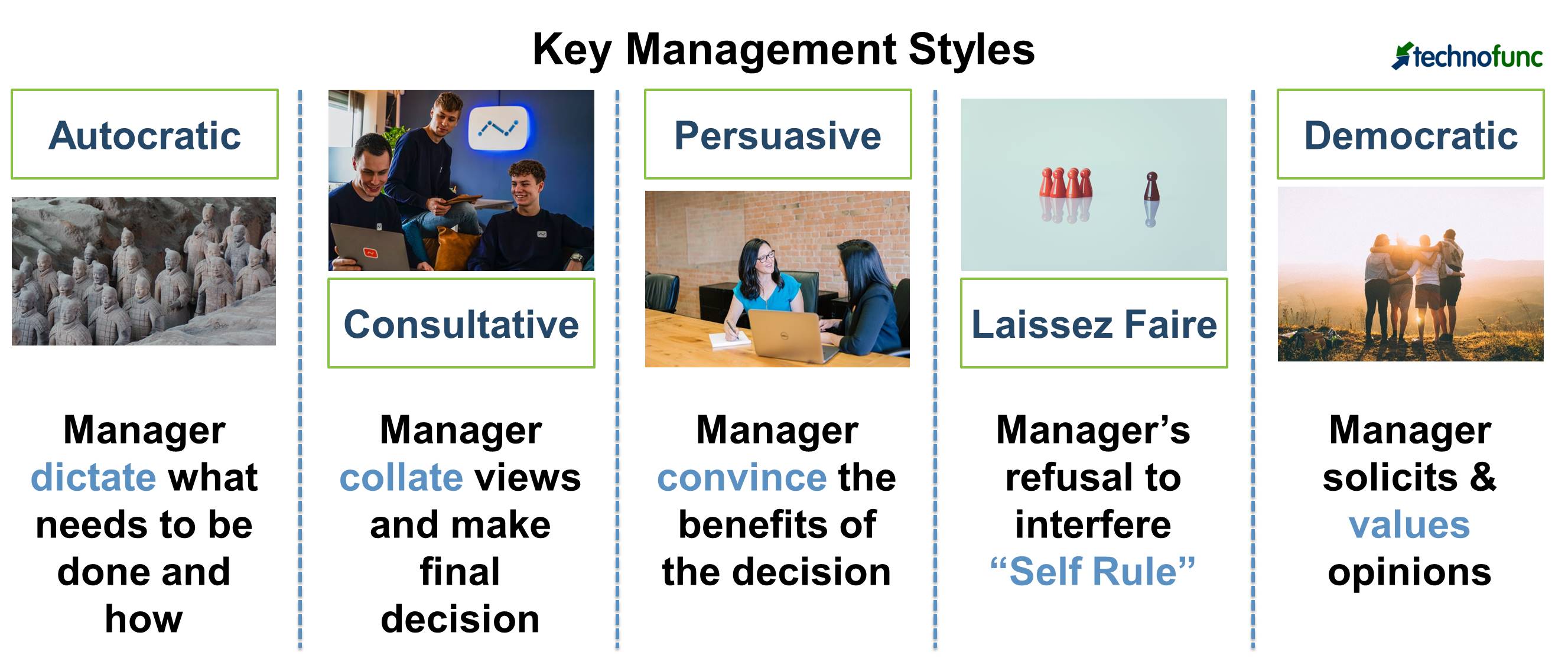- Home
- Business Processes
- Industry Knowledge
- Aerospace Industry
- Automotive Industry
- Banking Domain
- BFSI Industry
- Consumer/ FMCG Industry
- Chemicals Industry
- Engineering & Construction
- Energy Industry
- Education Domain
- Finance Domain
- Hospitality Domain
- Healthcare Industry
- Insurance Domain
- Retail Industry
- Travel and Tourism Domain
- Telecom Industry
- Leadership Skills
- eLearning
- Home
- Leadership Skills
- Leadership & Management
- Key Management Styles
Key Management Styles
Managers have to perform many roles in an organization, and how they handle various situations will depend on their style of management. Management styles are the characteristic ways, of making decisions relating to subordinates. These are the strategies, efforts, or direction used by the manager, to create an efficient workplace, to achieve organizational goals. A management style is the method of leadership used by a manager.
Role of a Manager
Managers perform the functions of motivating, directing, and communicating. The performance, efficiency, and effectiveness of any organization depend significantly on the managerial capability of the organization. Being promoted as a manager does not automatically get the respect, trust, and acceptance of your team members. In order to earn the position as a leader of the group and have a positive influence on the group members, managers must learn some specific leadership skills and methods.
Definition of Management Styles
Management styles are the characteristic ways, of making decisions relating to subordinates. These are the strategies, efforts, or direction used by the manager, to create an efficient workplace, to achieve organizational goals. A management style is the method of leadership used by a manager.
Different Types of Management Styles
Managers have to perform many roles in an organization, and how they handle various situations will depend on their style of management. The managerial quality and effectiveness are dependent on the style or approach they adopt for a given situation and show their leadership in the organization. Managers have the ability to bring change - either positive or negative. Good managerial skills are of great importance in today's times when the environment is highly dynamic due to technological advances, innovation, and entrepreneurship.
Various styles which have been broadly identified are:
- Authoritarian / Autocratic Management Style
- Consultative Management Style
- Persuasive Management Style
- Democratic Management Style
- Laissez Faire Management Style
- Adaptive Management Style
- Agile Management Style
- Appreciative Management Style
- Authentic Management Style
- Bad Management Style
- Bureaucratic Management Style Style
- Collaborative Management Style
- Crisis Management Style
- Cross-Cultural Management Style
- Directive Management Style
- Emergent Management Style
- Facilitative Management Style
- Lean Management Style
- Level 5 Management Style
- Narcissistic Management Style
- Narrative Management Style

Now let us understand some of these styles in details:
Autocratic Management Style
An autocratic style of management is when a manager makes a decision unilaterally. The manager conveys the decision to staff, and they have to work, within the scope of that decision. An authoritarian leadership style is being used when a leader who dictates policies and procedures, decides what goals are to be achieved, and directs and controls all activities without any meaningful participation by the subordinates. Authoritarian leaders are commonly referred to as autocratic leaders. Direct supervision is what they believe to be key in maintaining a successful environment and followership.
In fear of followers being unproductive, authoritarian leaders keep close supervision and feel this is necessary in order for anything to be done. Authoritarian leaders use their power to influence and tend to be task-oriented. It is also referred to as a directive or controlling style of leadership. Autocratic leadership allows quick decision-making and eliminates arguments over how and why things get done. Autocratically -led organizations are generally not supportive of personal relationships, but much more keyed to chain-of-command.
Consultative Management Style
In consultative style, the manager engages the subordinates efficaciously in the decision making and problem-solving process. Consultative style endorses the concept of empowerment. Communication is generally downward, but feedback to the management is encouraged to maintain morale. A consultative management style can be viewed as a combination of democratic and autocratic. The consultative manager will ask views and opinions from their staff, allowing them to feel involved but will ultimately make the final decision. This form allows for more discussion than an autocratic method but is essentially dictatorial.
Persuasive Management Style
Persuasive style of management is somewhat similar to the autocratic style of management. The major difference is that, despite holding the entire power of decision making, the persuasive manager spends more time, working with his subordinates, in order to try to convince them, of the benefits of the decision that has been made. A persuasive management style is characterized by strong, centralized control that makes decisions for the business. But, unlike autocratic managers, persuasive managers take the time to invite questions rather than levying “do this or else” policy mandates.
Democratic Management Style
A democratic style is a multilateral approach, where the manager allows the employees, to take part in decision-making, and therefore everything is agreed upon by the majority. This type of management style is mostly found in businesses, where efficiency is a joint operation. A democratic leader understands that there is no organization without its people. He looks at his and others' positions in terms of responsibilities rather than status and often consults in decision-making. The democratic style encompasses the notion that everyone, by virtue of their human status, should play a part in the group's decisions. Democratic leadership invites the participation of staff members and others, not only in decision-making but also in shaping the organization's vision.
While democratic leader solicits, values, and takes into account others' opinions, however, the ultimate responsibility for decision-making still lies reserved with the leader. Final decisions about what to do with the ideas from team members still remain in the hands of the leader. Such a leader believes that although the organization's success depends on collaboration and cooperation from all team members, accountability for the consequences of the decisions made still lies on the leader alone. Some models of democratic leadership might put responsibility in the hands of a small group like a management team or executive committee.
Laissez Faire Management Style
This French phrase means "leave it be," and it describes leaders who allow their people to work on their own. The laissez-faire leadership style was first described by Lewin, Lippitt, and White in 1938, along with the autocratic leadership and the democratic leadership styles. The laissez-faire style is sometimes described as a "hands-off" leadership style because the leader delegates the tasks to their followers while providing little or no direction to the followers. It allows followers a high degree of autonomy and self-rule, while at the same time offering guidance and support when requested. Laissez-Faire by definition means refusal to interfere. In Laissez-Faire style, the role of the manager is more like a mentor and stimulator, and the employees manage their respective areas of business. This type of management works only if the people involved are self-motivated and task-oriented.
Earlier we have seen that the management is defined as the process of getting things done through the efforts of other people. Both the definitions overlap and since managers get all sorts of things done through the efforts of other people, they must lead. In other words, by definition all managers are leaders. It is the manager in his leadership role who has to stimulate and inspire the employees to contribute willingly and cooperatively to the optimum achievement of organizational goals. In this context, one important term we can use, i.e., team. Generally, team members support one another. They offer suggestions and give feedback to other members. They may disagree but work to resolve differences and reach consensus. Each and every member of the team trust and support other members.
The success of an organization depends much on the quality of a leader and thus a strong leadership can contribute to the overall effectiveness of the organization. Managers should realize that leaders have qualities that can be developed through training or simply by awareness. Homing leadership skills as a manager, one can become a better team player and a better professional.
Related Links
You May Also Like
-
Team leadership theory is a recent leadership theory that does not discriminate between the leader and the other team members. The approach considers contributions from each team member to be critical for organizational success. This approach focused on the overall team effectiveness and team problems are diagnosed and action is taken to remediate weakness. This approach provides for taking corrective action when the leader deems necessary.
-
In this study of power, Raven identified five bases of power as coercive, reward, legitimate, referent, and expert. The 5 Types of Power can help you decide when it is appropriate to use a particular type of power in important situations. Leadership involves authority and it is very important for leaders to understand what type of power they're using.
-
Administrative Theory by Fayol
The administrative theory of management is focused on principles that could be used by managers to coordinate the internal activities of organizations. The most prominent of the administrative theorists was Henri Fayol. Fayol observed a work stoppage and judged it to be a management failure. He believed that organizational managerial practices are important for driving predictability and efficiency in organizations.
-
Power is the ability to exercise influence or control over others. Leadership involves authority and it is very important for leaders to understand what type of power they're using. The 5 Types of Power in Leadership are Coercive power, expert power, legitimate power, referent power, and reward power. Authority is the right to command and extract obedience from others. It comes from the organization and it allows the leader to use power.
-
Many different types of teams have been identified by social scientists. Managers may encounter the diverse types of challenges while managing different kinds of teams. Challenges associated with Cross-Functional Teams might be different from that of a Geographically Dispersed Team or a Virtual Team. This article explores some common categories and subtypes of teams.
-
Management theories are the recommended management strategies that enable us to better understand and approach management. Many management frameworks and guidelines were developed during the last four decades.
-
In its simplest sense, decision-making is the act of choosing between two or more courses of action. Decision making is a key skill in the workplace and is particularly important if you want to be an effective leader. When decisions have to be made, there are several stages that you should go through to reach a practical solution. Understand the meaning and importance of decision making and how to look at it as a process.
-
Tools for Developing Your Team
If a manager has too many weak spots in the talent of the team, the ability to empower the team members to independently execute the project is impaired. Assignments fall behind schedule or stretch out because the needed skills or knowledge are not in place when needed. To successfully execute important projects, hiring talented people, and increasing the talents of existing staff are most important.
-
Modern Approaches to Management
The modern approaches to management look at organizational management in the current context. They take a holistic approach and look at organizations as a collection of interrelated parts influenced by both internal dynamics and also the larger external environment. These modern management theories have played a significant role in the evolution of management studies.
-
Behavioral Approach to Management
The behavioral management theory had a profound influence on management by focusing on understanding the human dimensions of work. It is also called human relations movement as behavioral theorists focused on managing productivity by understanding factors of worker motivation like their needs and expectations, personality, attitudes, values, group behavior, conflict, and group dynamics. It advocated the use of psychological techniques to motivate employees.
Explore Our Free Training Articles or
Sign Up to Start With Our eLearning Courses

About Us
Learning
© 2023 TechnoFunc, All Rights Reserved










